Ice Fishing for Bluegill
I am the beneficiary of teachers with outstanding minds. A dozen years ago Heath Wagner (Smallmouth Bass Records with Heath Wagner) took me ice fishing for bluegill. He showed me how to maximize my time and fish catching. Beyond setting up tip-ups for northern pike as a teenager, I had zero experience ice fishing. Never before had I targeted panfish through the ice, but I wanted to learn.
He first took me sight fishing on Clear Lake in Northeast Indiana. I consider myself tough, but the 8-degree temperature with 30+ mph winds taught me how extreme this hobby can be. It took days for my toes to thaw!
Hard Lessons of Ice Fishing for Bluegill
Clear Lake is exactly that – clear. The two of us sat in a shanty and looked down through the 5-inch hole. He tied a 1/16 ounce black with purple flake jig tipped with a white spike on a rod with 2-pound test fishing line. He handed it to me, instructed me to drop it down to the top of the weeds, give it a shimmy action, and told me to watch. In a matter seconds a 10-inch bluegill swam up, sucked in the offering, and spit it out in a fraction of a second. Bummer!
Growing up I caught bluegill with wax worms under a bobber from a row boat. As a general rule of thumb, I was taught not to set the hook until the bobber was completely submerged, which I began applying that day with Heath. Wrong. This was lesson number one.
“Why didn’t you set the hook, Mr. Buss?” Wagner sarcastically asked.
“He didn’t swim off with it,” I retorted.
After a brief giggle, “You might want to speed up your reaction time.”
“Why?” I asked.
“You saw how fast he spit that bait out,” he explained. “That’s what they do. If you wait for them to swim off with it, you’ll hardly catch any.” Prophetically, he predicted, “If you meet someone using a bobber on the ice, they’ll surely complain at some point how the fish are ‘just nibbling the bait and not taking it,’ but they are not eating it. They do just what you saw. The moment you see it bite, set the hook. With time you’ll begin anticipating the bite.”

More lessons on ice fishing for bluegill
He had positioned us on top of some aquatic vegetation that rose 3 feet off the bottom in 10 feet of water. The water was so clear, I could see every detail. As a result, my belief system that fish do not move during the winter was shattered. Bluegills, crappie, perch, bass, rainbow trout, and enormous northern pike swam directly below my feet! It was like an aquarium. Some bit my jig, which I aptly caught under Heath’s tutelage, but I was stunned to witness the constant cycle of these fish. Their movement was perpetual: a profound lesson indeed.
Sometime later, Heath left the shanty to look for other areas to fish. While staring down the hole, it suddenly disappeared – the wind was blowing my shanty across the lake! Lesson number 3: stake down a shanty on windy days.
Bluegill Movement under the Ice
The next lesson Wagner shared was, “Get out of the shanty!” On that day at Clear Lake, staying in a shanty was necessary because of the weather. Freezing temperatures freeze holes in a matter of seconds, plus the wind made it impossible to detect bites. But under better conditions, leaving the shanty home has better results. It comes down to maximizing time.
After a couple decades of ice fishing, Wagner has perfected his strategy of catching bluegills, and it involves burning a lot of calories. While many gain weight over the holidays, Wagner often loses some. “Fish are constantly on the move, so I do the same.” Ice anglers will catch fish by hovering over a high percentage area. Patience will pay off as schools of fish move through, which will provide minutes of action in between many minutes of inactivity. The school may return every 15 minutes or every two hours, and consistency will yield fish. But Wagner is more aggressive: “Why wait for them, if I can stay on top of them?”
How to Catch More Bluegill Ice Fishing
Even before turning on his Vexilar unit, Wagner begins by drilling holes – lots of them! “Turn the lake into Swiss cheese.” A minimum of two dozen holes is drilled before dropping a line, but four dozen may be drilled before the day is over. Wherever the ice grows thick, investing in a power auger can save an elbow! His goal is to drill enough holes that he can move with the school of fish. He pays attention to where other anglers catch fish and which holes of his have produced. After a while, it is possible to begin predicting where the school is moving next.
Often bluegill relate to weed beds, and they travel from one to the next. Where weeds do not exist, they will relate to other structure such as rock, wood, or different bottom composition. Whatever it is, they may be redundant in their cycle, allowing an observant angler to anticipate their movements. Thus, after the bite fizzles from a hole, an angler can greet them at their next stop. This will cut out the dead time and maximize time on the water.
Catch Bluegill through the Ice
A flasher such as a Vexilar is a must. This allows an angler to drop a transducer in a hole and know immediately if a fish is within range. The lack of a flasher creates a colossal guessing game. Once Wagner drills the initial two dozen holes, he sets up his rod, then walks from one hole to the next until he locates a fish on the flasher. If none of the holes show fish, he drills more but will revisit them later.
His rod is set up with tiny 1/16 ounce or 1/32-ounce jigs, which he tips with a spike. The jig is dropped down below the fish, which is viewed on the flasher, and then raised with a painfully slow and undulating action by and above the fish. “Bluegill do not have the ability to look down,” he taught me. “Dropping it below them ensures you are able to maximize the time the bait is in the strike zone, because you begin out of its line of vision, and you then go from being in its face to well above it.”
While not thought of as an apex predator, the bluegill is still a predator, and an easy meal slowly getting out of striking distance is often too hard to resist. “If the fish does not bite as it is in front of its face, keep bringing it up; sometimes five feet. Eventually, you’ll see on the graph the bluegill rising to the bait, which means it is about to bite. Pay close attention: set the hook as soon as you detect any resistance.” Installing a spring bobber to a rod will help detect subtle bites.
Ice Fishing for Bluegill: Where to Catch Them
There is good news when finding fish through 5-inch holes on a lake: bluegills and other fish tend to winter in the same areas every year. So, once an angler learns this, they can count on that area producing year after year. If unsure where the fish winter at, follow the crowd. The crowd comes to an area for good reason – the fish are there.
However, if unfamiliar with a body of water and a lack of other ice anglers to follow, look for these features:
1. Channels. Any channel with a depth of eight feet or more is a magnet to bluegill. These channels may not produce fish as big as the main lake, but it freezes first and offers early season action.
2. Deep Holes. Any time a circular shape of deep water is surrounded by shallow water is a magnet for fish. Schools of bluegill will circumnavigate the depth relating to whatever cover is present.
3. Flats. These are areas where shallow water extends out into deep water before suddenly dropping off into deep water. Typically, flats slowly taper deeper before the drop off, but instead of drastic contour changes, it is normally by inches. Like the deep holes, bluegill travel throughout these areas using whatever structure is available.
It is best to begin searching for these areas on the north shore. This shoreline receives the most sunlight and is often protected from bitter north winds.
Ice Fishing for Bluegill: Tackle
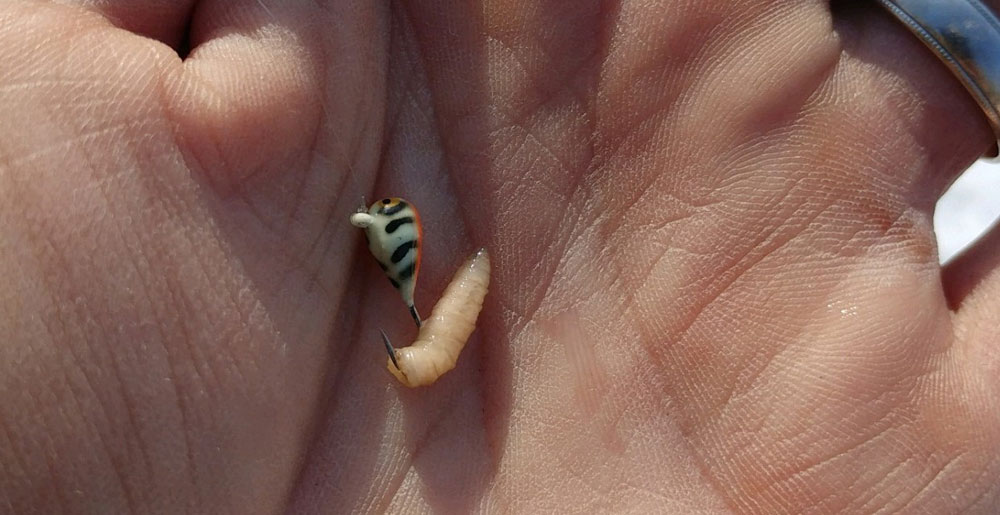
Ice fishing rods are normally no longer than three feet in length. Choose one with moderate to big guides. When in freezing temperatures, small guides can freeze up from the water it collects when retrieving line. Because of the lack of sensitivity, very few baitcasting reels or rods exist for bluegill. The aforementioned spring bobber helps detect subtle bites from bluegill and is also inexpensive. They attach to the tip of the rod.
Bluegill mouths are small, so stick with small 1/32- and 1/16-ounce jigs so they can be sucked in with their small mouths. Numerous quality models made with lead exist but be picky about the hook. A sharp hook is vital. If fishing in depths greater than 12 feet, consider paying more for a tungsten weight jig. Tungsten is much denser, so they weigh more at the same size of lead.
This will cause it to sink faster while maintaining the small size. Choose a variety of colors and don’t be afraid to experiment. Numerous factors such as snow cover, sunlight, cloud cover, water color, and shad from a shanty will change the colors of the bluegill’s food.
Thick fishing line will kill the action of the jig and sink too slowly. When in crystal clear water, use 2-pound test; otherwise, 3-pound test will suffice.
Just as installing Megaware boat protective products will help you fish with confidence, following these tips will produce results and put the delicious bluegill in your frying pan.

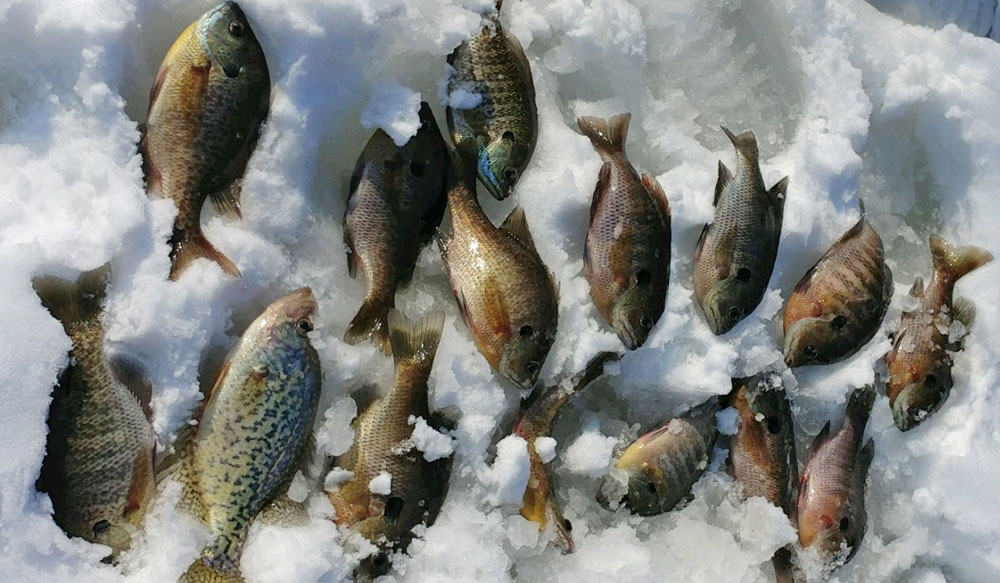
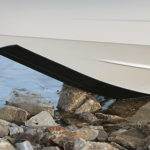

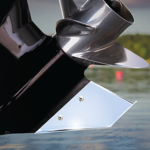

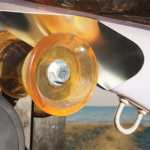
Comments